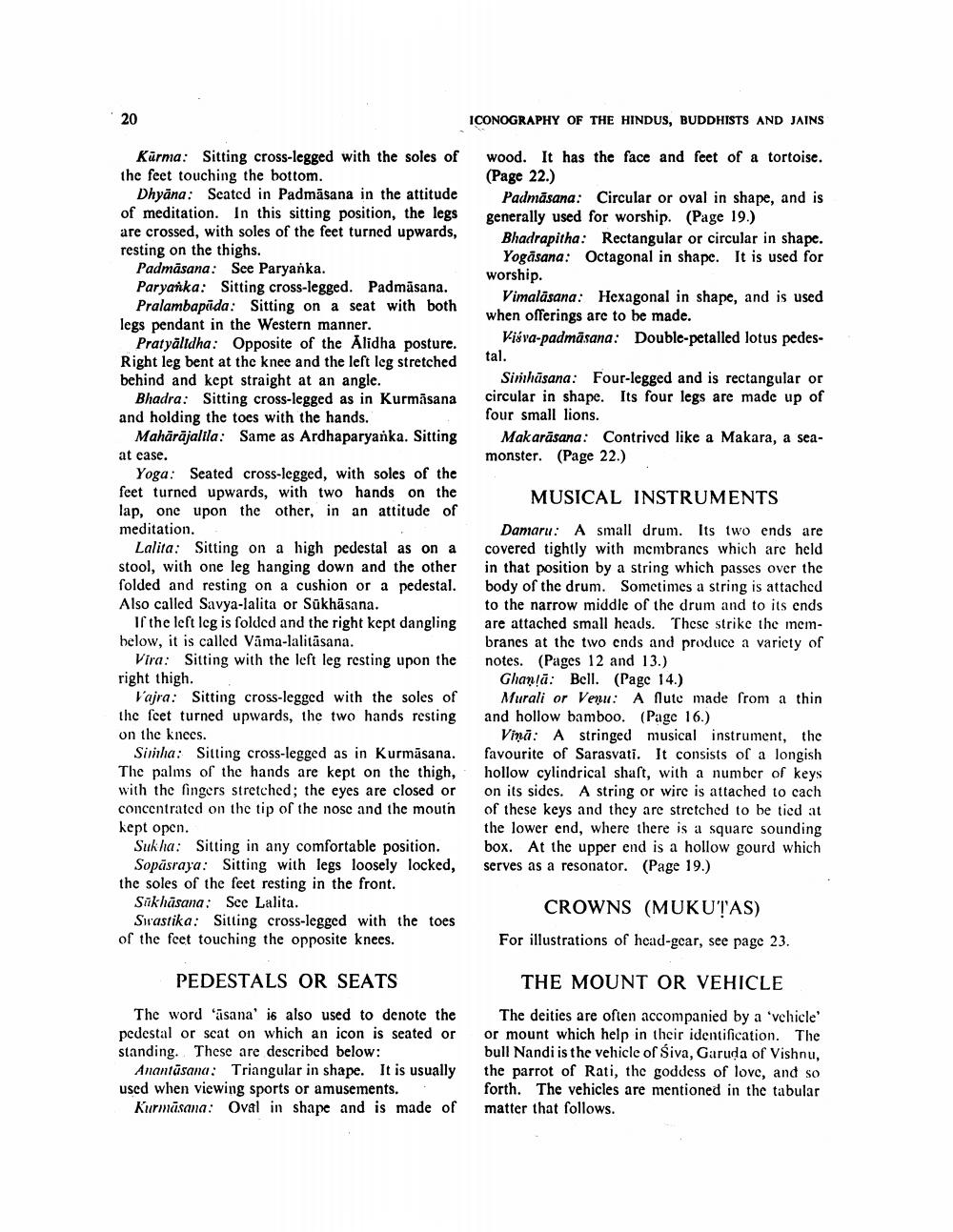________________
20
Kurma: Sitting cross-legged with the soles of the feet touching the bottom.
Dhyana: Seated in Padmasana in the attitude of meditation. In this sitting position, the legs are crossed, with soles of the feet turned upwards, resting on the thighs.
Padmasana: See Paryanka.
Paryanka: Sitting cross-legged. Padmasana. Pralambapada: Sitting on a seat with both legs pendant in the Western manner.
Pratyalidha: Opposite of the Alidha posture. Right leg bent at the knee and the left leg stretched behind and kept straight at an angle.
Bhadra: Sitting cross-legged as in Kurmāsana and holding the toes with the hands. Mahārājalila: Same as Ardhaparyanka. Sitting at ease.
Yoga: Seated cross-legged, with soles of the feet turned upwards, with two hands on the lap, one upon the other, in an attitude of meditation.
Lalita: Sitting on a high pedestal as on a stool, with one leg hanging down and the other folded and resting on a cushion or a pedestal. Also called Savya-lalita or Sukhāsana.
If the left leg is folded and the right kept dangling below, it is called Vama-lalitāsana.
Vira: Sitting with the left leg resting upon the right thigh.
Vajra: Sitting cross-legged with the soles of the feet turned upwards, the two hands resting on the knees.
Simha: Sitting cross-legged as in Kurmāsana. The palms of the hands are kept on the thigh, with the fingers stretched; the eyes are closed or concentrated on the tip of the nose and the mouth kept open.
Sukha: Sitting in any comfortable position. Sopasraya: Sitting with legs loosely locked, the soles of the feet resting in the front.
Sukhasana: See Lalita.
Swastika: Sitting cross-legged with the toes of the feet touching the opposite knees.
PEDESTALS OR SEATS
The word 'asana' is also used to denote the pedestal or seat on which an icon is seated or standing. These are described below:
Anantasana: Triangular in shape. It is usually used when viewing sports or amusements. Kurmāsana: Oval in shape and is made of
ICONOGRAPHY OF THE HINDUS, BUDDHISTS AND JAINS
wood. It has the face and feet of a tortoise. (Page 22.)
Padmasana: Circular or oval in shape, and is generally used for worship. (Page 19.)
Bhadrapitha: Rectangular or circular in shape. Yogasana: Octagonal in shape. It is used for worship.
Vimalasana: Hexagonal in shape, and is used when offerings are to be made.
Viśva-padmasana: Double-petalled lotus pedes
tal.
Simhasana: Four-legged and is rectangular or circular in shape. Its four legs are made up of four small lions.
Makarasana: Contrived like a Makara, a seamonster. (Page 22.)
MUSICAL INSTRUMENTS
Damaru: A small drum. Its two ends are covered tightly with membranes which are held in that position by a string which passes over the body of the drum. Sometimes a string is attached to the narrow middle of the drum and to its ends are attached small heads. These strike the membranes at the two ends and produce a variety of notes. (Pages 12 and 13.)
Ghanta: Bell. (Page 14.)
Murali or Venu: A flute made from a thin and hollow bamboo. (Page 16.)
Vina: A stringed musical instrument, the favourite of Sarasvati. It consists of a longish hollow cylindrical shaft, with a number of keys on its sides. A string or wire is attached to cach of these keys and they are stretched to be tied at the lower end, where there is a square sounding box. At the upper end is a hollow gourd which serves as a resonator. (Page 19.)
CROWNS (MUKUTAS)
For illustrations of head-gear, see page 23.
THE MOUNT OR VEHICLE
The deities are often accompanied by a 'vehicle' or mount which help in their identification. The bull Nandi is the vehicle of Siva, Garuda of Vishnu, the parrot of Rati, the goddess of love, and so forth. The vehicles are mentioned in the tabular matter that follows.




